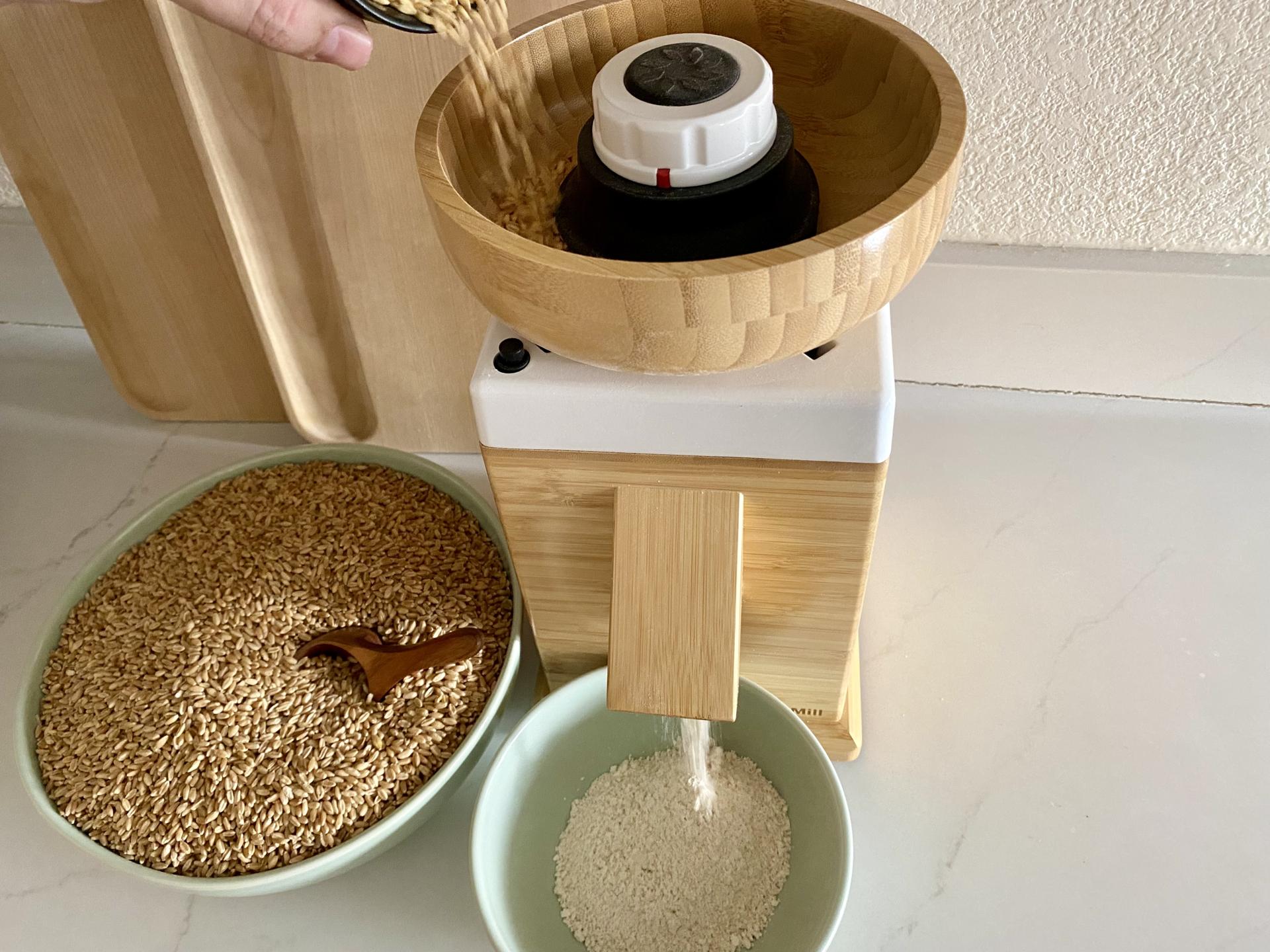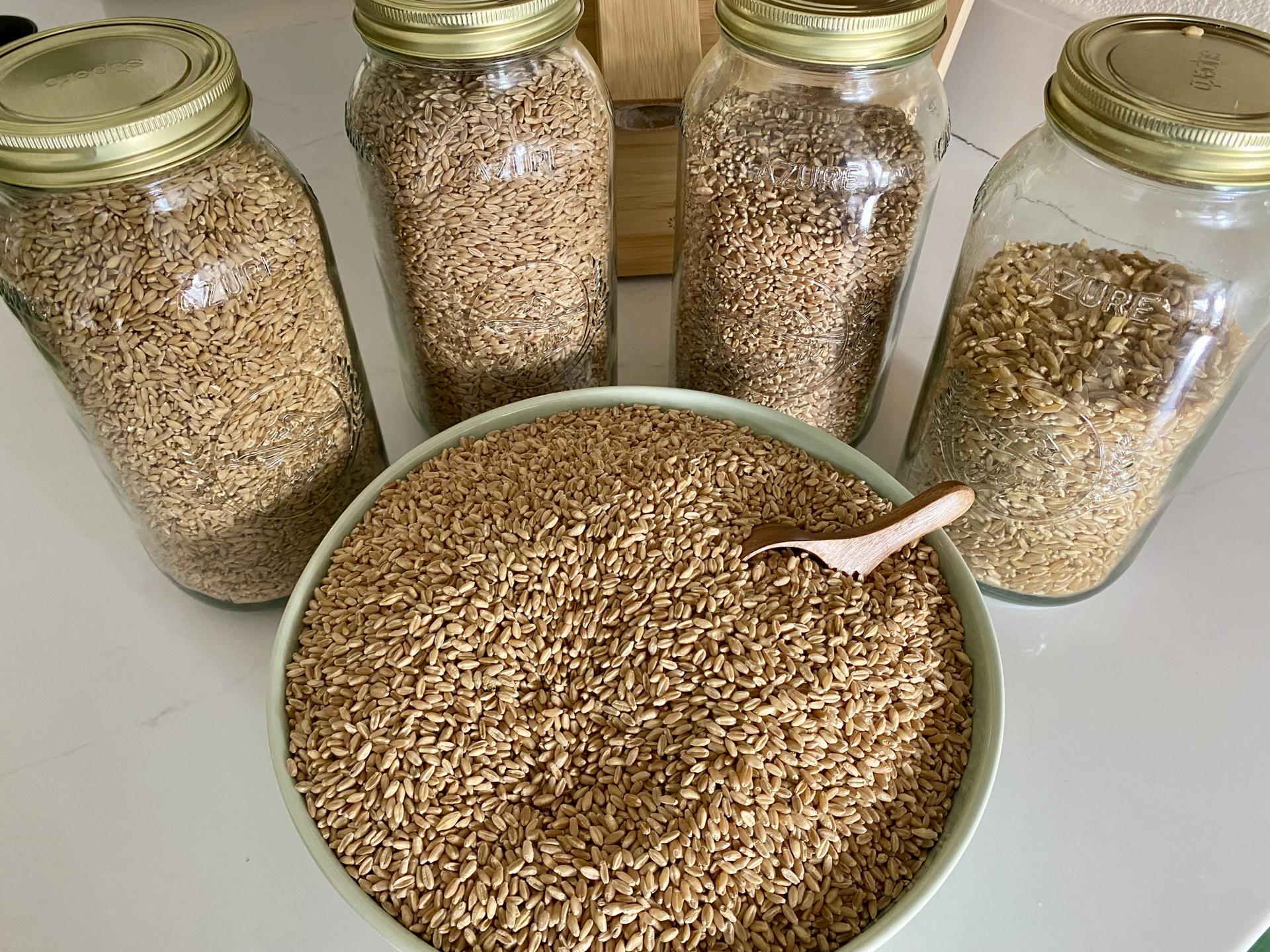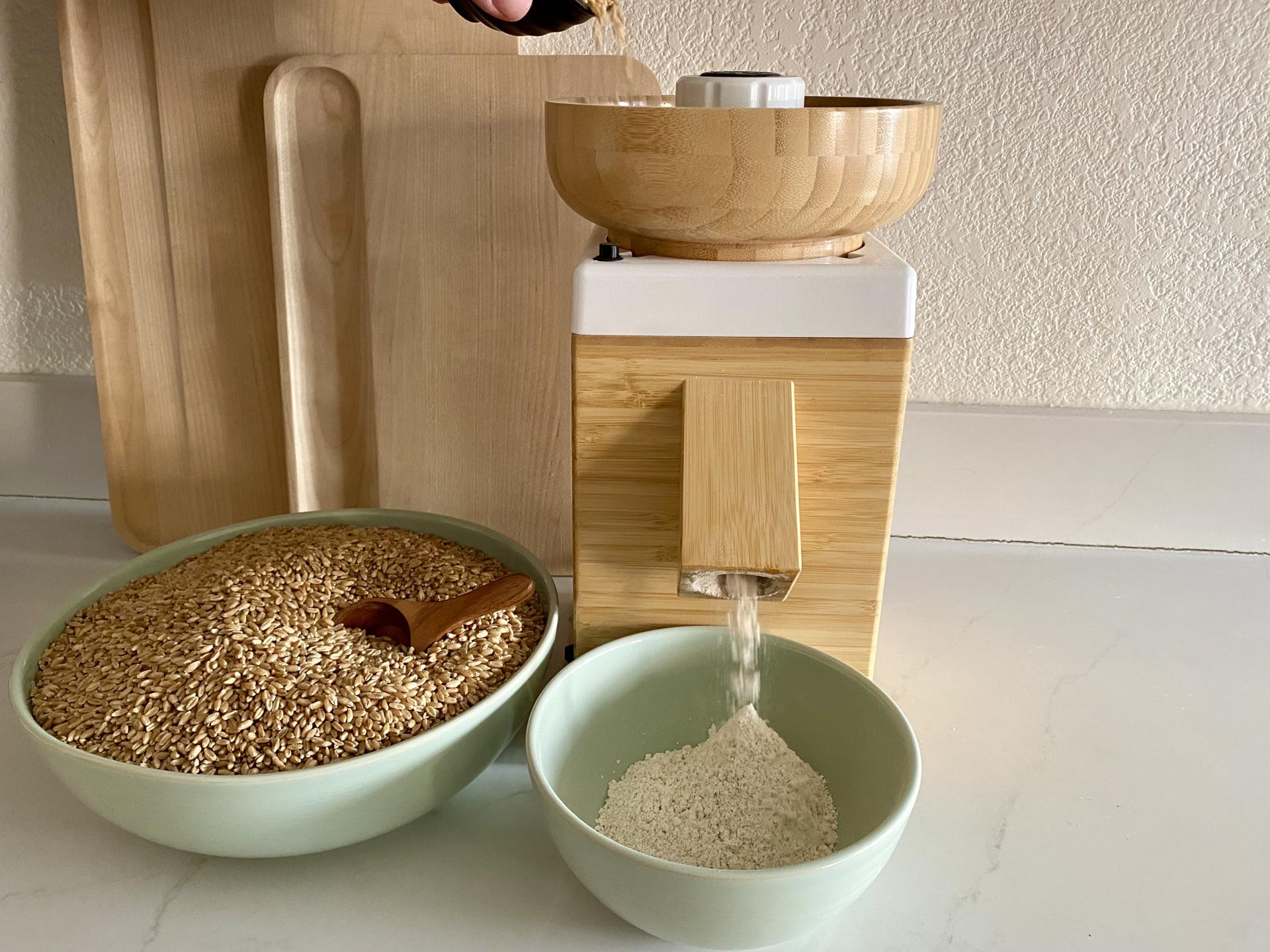Why I chose to mill my own grains.
This post contains affiliate links. If you use these links to buy something I may earn a small commission. See my full disclosure here.
Growing up, I ate plenty of bread from the store and baked goods made with white, all-purpose flour. My mom made cakes as a hobby, and gave out Christmas cookies as gifts so we went through pounds of flour. This, like most Americans, was the only concept of wheat I knew.
If you’ve read about my experience limiting seed oils, then you know a bit about my health struggles, but if not, here’s a quick rundown.
After I had my first baby, I, like so many other women, began having trouble with the gallbladder in the first months postpartum (not cool gallbladder. Not cool.). Three months after I had her, I had my gallbladder removed and my digestion has never been the same.
Don’t get me wrong, it was never great to begin with. I’ve always had irregular bowel movements and a sensitive stomach that would occasionally require me to rush to the bathroom a few minutes after consuming a certain food, but my digestive system was by no means “regular” or predictable.
I noticed that after I ate highly-proceed, seed-oil-full meals, things would get particularly bad, to the point that there would be several days in a row I couldn’t get out of bed except to rush to the bathroom, which I did at least 20 times a day.
But even when I wasn’t in a “flare up” things weren’t great. I had almost constant pain on my right side–ultrasounds and various other tests revealed nothing. At this point, I decided to cut out seed oils for a full 30 days to see if it helped, and it did make a huge difference!
As I stated in my seed-oil post, if you cut out seed oils, you cut out almost every single highly processed food. This all helped a lot, but the issues didn’t completely go away. There was much less rushing to the bathroom after a meal, but my digestive system was still unpredictable.
Since I was already having to make almost all my own bread products, I started looking into the healthiest flour and sweetener options that I could use. The hard part is getting into the rhythm of making your own bread products–once you’re there, the flour you use adds no additional difficulty.
As I was researching, I was reminded how hated “gluten” and wheat products in general are in our modern society. I have more friends than I can count that try to limit gluten or avoid it completely.
As a Christian with mostly Christian friends I started to find this curious. I mean Jesus says “I am the bread of life.” John 6:35. If Jesus is teaching by comparing himself to bread then bread can’t be as bad as modern day “health experts” say it is right?
In my research, I stumbled across a YouTube video by a mom discussing a few of the health benefits of milling your own flour. And that changed everything. I showed my husband the video and we ordered a grain mill. But little did I know that was only the tip of the iceberg when it comes to the incredible benefits of milling your own grains.
Since milling my own grain, my bowel movements have largely stabilized. I have increased energy and am more easily satiated. I have eaten bread products made with store-bought organic all-purpose flour since making the switch to milling all my own grains and the difference I feel in my body is night and day. With the all-purpose flour products, I feel bloated, sluggish, my stomach hurts, and I feel overall yucky. Not so with freshly milled flour.
As a mama of two littles who not only wants my kids to grow up with optimal nutrition, but who also wants to be optimally healthy for them, I will NEVER go back to using store bought flour.
If this is resonating with you, stick with me. It may seem intimidating, but I promise, compared to some of the other “healthy” things we’re told to do, this one is so manageable and so worth it!
What are whole grains?
Whole grains are actually the whole seeds of a plant. Specifically, whole grains are the seeds of cereal grasses–yes, wheat is actually a grass!
A whole grain seed contains three distinct parts–the outer layer, called the bran; the middle layer, called the endosperm; and the innermost layer, called the germ. For a food to be truly whole grain, it must contain 100% of every layer–the bran, endosperm, and the germ.
Some common whole grains include:
- Amaranth
- Barley
- Buckwheat
- Corn (you can mill your own cornmeal!)
- Millet
- Oats
- Quinoa
- Brown rice
- Rye
- Wheat (this includes all the wheat varieties such as hard red wheat, hard white wheat, soft white wheat, spelt, einkorn, kamut, and emmer)
What does it mean to mill your own flour?
Are you picturing a donkey in a silo pushing a big stone mill to crush grains? Well I’m not saying you can’t mill your grains that way, but I am saying there is a much better solution that sits on your counter–a grain mill.
Electric grain mills are relatively compact kitchen appliances that easily fit on your counter. When you’re ready to mill some grain, just turn on your mill, dump in your wheat berries, and voila! Within seconds you have freshly milled flour.
There are two basic types of grain mills–stone mills and steel mills. A stone mill uses two stones (moving very fast) to grind your wheat. A steel mill uses two steel plates (they took the design from the machine a pharmacist uses to grind medications). They will both work great! I have a NutriMill stone mill–strictly because it’s prettier–I mean if you have to buy something you might as well get the pretty one, right? But the steel mills can be cheaper, and mill a finer flour. WonderMill also has a great steel mill. Do a little additional research to figure out which mill is right for your family!
What are the benefits of eating whole grains, specifically wheat?
Remember, I’m not a doctor. I’m just a mama trying to make health choices for her family. Please research the benefits of eating whole grains yourself and talk to your doctor about it. Here’s why I mill flour for my family.
The human body needs 44 essential nutrients–40 of those are found in wheat! The only nutrients missing are vitamin A (eat your dark vegetables, eggs, and fish), vitamin C (eat your citrus fruits), vitamin D (spend 15 minutes a day in the sun without sunscreen), and while wheat has some vitamin B, it does have all the vitamin B your body needs (so again, eat your fish and eggs).
What other food do you know that has 40 of the 44 essential nutrients for life? I can’t think of one. And I think this makes sense. Wheat is relatively easy to grow, and essentially stores indefinitely. Of course a God as good as ours created a food capable of being easily stored that can sustain human life through the fruitful times and the lean times (think about the story of Joseph in the Old Testament storing grain to sustain not only Egypt, but surrounding countries through 7 years of drought. See Genesis chapters 37–50).
The fiber in the bran helps slow the breakdown of the starch and protein contained in the endosperm which helps stabilize blood sugar instead of causing blood sugar spikes like white flour alone does. The fiber can also help lower cholesterol, and aid in preventing constipation or IBS.
The vitamin E found in the germ is a powerful antioxidant that helps prevent cell damage, helps reduce the risk of heart disease and is great for eye health.
Eating whole wheat can also reduce the risk of chronic diseases like cancer and type 2 diabetes. And while it may sound weird it can also help by preventing or treating warts.
And this is only a small sampling of the amazing health benefits of eating whole grain–in particle–whole wheat.
Why can’t I just buy whole grain flour or whole grain products from the store?
At this point you may be thinking, “okay great! I’m in! The benefits of whole grains seem totally worth it! But why do I have to mill my own flour? Why can’t I just buy whole wheat flour or whole wheat bread from the store.” To which I say, “fair question.” Friend, please hear me on this–whole wheat flour and whole wheat bread bought at the store is NOT THE SAME as the whole wheat flour produced from milling your own grains. In fact, whole wheat bread is the only real, whole food that you cannot purchase at the grocery store. You can get real eggs, real butter, real meat, real fruit, real vegetables, real beans, but you cannot get real bread.
This is because of the way that flour is produced. To make all-purpose flour, the wheat berry is crushed and the bran and the germ are shifted away leaving only the endosperm. The endosperm is basically only protein and starch, and is what we all know as white flour.
To produce whole wheat flour, the same process is followed, only at the end, some of the bran and germ are put back in with the endosperm–but not in the same quantities that came out. And this is the only way to produce either white or whole wheat shelf-stable flour in mass.
You see, while the wheat berry stays whole and intact, it is preserved–if kept from moisture and pests, it will keep almost indefinitely. But as soon as you break open that wheat berry, you expose all its nutrients into the air, and those nutrients–especially vitamin E–begin to oxidise very quickly–some studies even show that up to 90% of the wheat berry’s nutrients are lost in only the first 3 days. Because of the oxidation, freshly milled flour will go rancid relatively quickly–well before it is able to be packaged and shipped across the United States to be sold.
Think about an apple turning brown after you take a bite of it–that’s an example of oxidation. Just like a grocery store can’t cut up an apple and leave it sitting on the shelf to sell you without making some alterations to prevent it from going bad, neither can they sell freshly milled grains–thus the processes described above must be used to allow for shelf-stable flour.
It wasn’t until the early 1900s that this process was developed and implemented on a mass scale. Before then, families either had a way to mill their grains at home or communities were built around a local miller where families would take their grains to be milled on a regular basis (there’s a mill road next to me, how about you?).
This is why if you truly want to reap the benefits of whole wheat, you must mill it yourself.
How do I get started?
- You have to have a grain mill.

Unless you are so incredibly lucky as to live next to a flour mill that mills their flour and sells it to you whole the day they milled it, you have to get a grain mill. I understand they can be pricey (NutraMill does have a fantastic mill that is only $200) and you may have to spend a few months to save up, but have you read those health benefits? What if your family could get the sniffles one time less often, how much would that save you? Could the mill pay for itself?
Also note that wheat berries are generally pretty inexpensive–maybe $20-$40 for a 25lb bag. How much does the bread and bread products like buns, pizza dough, and dinner rolls cost you? Could the mill end up paying for itself?
Ask for the mill as a birthday, Christmas, or Mother’s day gift. And if you truly truly cannot afford it, Bread Beckers does have a non-profit where they give mills to those who truly cannot afford it. I’m not sure of the specifics of that program, but if you feel you are in this camp, reach out to them and see if they can help.
- You need wheat berries.

The mill is no good without some wheat berries! You really only need two kinds–a hard wheat for yeasted bread, and a soft wheat for any non-yeasted bread (so a recipe where the leavening agent is baking soda or baking powder like cakes and cookies). If you are truly strapped for cash, you can technically use hard wheat in non-yeasted bread, but you cannot use soft wheat for yeasted bread. Soft wheat lacks the protein content needed for the yeast to rise the dough.
I generally use three different kinds of wheat berries–hard red wheat, hard white wheat, and soft white wheat. Hard red wheat has a delicious nutty flavor and is perfect for breads and buns. Hard white wheat has a more mild flavor and is perfect for any yeasted bread recipe where you want the non-bread components to stick out–like cinnamon rolls or pizza. Soft white wheat is perfect for all your pastries!
There’s a lot of talk about “ancient grains” right now–e.i. einkorn, spelt, and kamut. You can use those if you want, but they do tend to be a bit more expensive than your traditional grains. If you have it in the budget though, they are also delicious and you should definitely give them a try! There’s no difference nutritionally between ancient grains and modern grains.
So where can I buy these grains, you may be wondering. I get most of my grains from Azure Standard. They deliver monthly to different co-op locations around the U.S. Go to their website to see if they have a co-op near you. If you live in the south, Bread Beckers has a store near Atlanta where you can buy anything you can possibly imagine relating to freshly milling your own flour. If you live in the southwest, Winco sells a bag of bulk wheat berries in their bulk section.
You can also google and see if there are any other specialty stores near you that sell the wheat berries. If all else fails, you can always order grains from Amazon–you can get hard red wheat, hard white wheat, and soft white wheat shipped to you–or Guardian Grains.
- You kinda need a mixer.
I say kinda because you don’t need a mixer for non-yeasted breads, like cakes and cookies (sometimes it’s easier to use a bowl and a spoon even if you have a mixer), and you can hand knead your yeasted dough. So if you’re strapped for cash, you can make all the bread for your family without one. But hand kneading gets very old very quickly.
If you have a KitchenAid you can certainly use the dough hook attachment, but KitchenAid recommend certain rest times for the machine while you’re kneading dough, so look into it to see how best to handle this with your machine. I started making bread with a KitchenAid–a few months in, there was smoke coming out the back.
So if you burn yours up, or if you don’t have a mixer and you’re looking to get a new one, get an Ankarsrum Mixer! I know it’s expensive but it will likely be the last mixer you ever buy in your life!
- You need a few basic recipes.
Now let’s make some bread! Learning any new skill or getting into any new routine is hard–don’t overcomplicate it! You don’t need a different recipe for bread, pizza, dinner rolls, hamburger buns, hotdog buns, etc. when you get started. Find one basic yeasted bread recipe you like and use it for all your yeasted breads–buns, pizza, bread, rolls, etc. Sure once you’re in the groove it can be fun to start experimenting with different recipes, but at the beginning, just work on learning how to make bread, and fitting that task into your daily routine.
Employ that same method across the board. Find a muffin recipe you like and always make that. Swap out the blueberries for chocolate chips or strawberries. Find pastries you like and find a simple doable recipe for those items. Remember, freshly milled flour is the most nutritional food that God has given us. That means it’s actually an incredibly healthy cookie!
Best tips for successfully milling your own grains.
So, to summarize, if you want to start reaping the enormous benefits of milling your own grains,
- Just get started. It may seem overwhelming at first, but milling your own wheat really doesn’t add any time to the baking process. If yeasted breads intimidate you, start with cookies, coffee cake, or muffins. Remember, when made with whole wheat these items are a health food, not a junk food.
- Don’t overcomplicate it–stick with a few basic recipes and add different additions to change the flavor, or shape yeasted dough differently to get a different product like dinner rolls or pizza.
- Give yourself a challenge to eat something made with whole wheat everyday for 30 days and see if you see any changes.
Now let’s get baking!
Love,
This mama



Leave a Reply